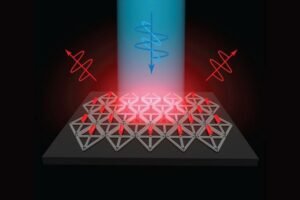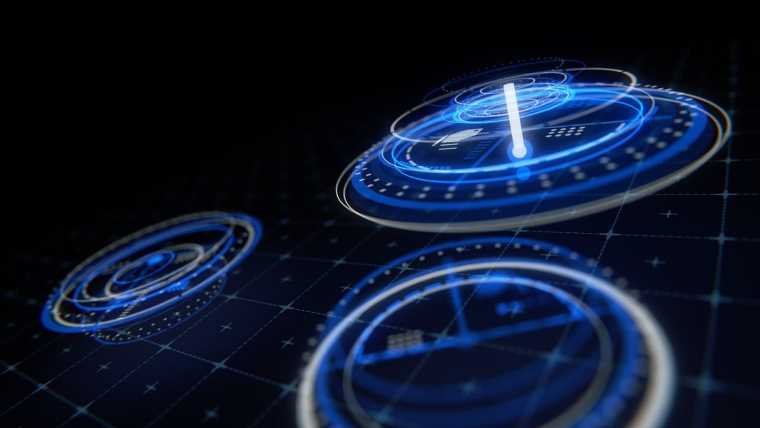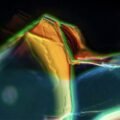A breakthrough at the Massachusetts Institute of Technology (MIT), funded by the Department of Energy (DOE), is utilizing the power of DNA to align quantum rods that may help usher in a new era of enhanced televisions and ultra-realistic virtual reality (VR) devices.
Some modern high-end TVs already make use of the dynamic luminescent qualities of two-dimensional (2D) quantum dots, but finding a way to tap into the superior qualities of their two-dimensional cousins, quantum rods, has remained elusive. However, the researchers behind this latest effort claim that the situation has now changed.
The Secrets of Realistic VR and Star Trek Holodecks May Lie in the Quantum Realm
In science fiction, things like holograms and virtual reality are often commonplace. However, present-day engineers are still working to improve both technologies enough that they function anywhere close to a Star Wars distress hologram from Princess Leia, let alone a full-blown Star Trek-style holodeck that looks and feels like reality.
As a matter of fact, there are still ongoing efforts to improve TVs, monitors, or even the screens on mobile devices that don’t involve 3D holograms of virtual reality. In some cases, those engineers have begun to turn to the quantum realm for answers. That’s because, along with their extreme strength and durability, two-dimensional materials like graphene or quantum dots also offer a wide array of optical and electromagnet properties.
Unfortunately, none of those efforts have been able to tap into the exceptional optical properties of quantum rods, which include the ability to control both the polarization and color of light. Both are qualities needed in many virtual reality and holographic technology concepts.
The main issue has been that the quantum rods, which are essentially elongated quantum dots, all need to line up in the same direction to be of any use, or their properties often cancel each other out. Still, getting them to align has been nearly impossible.
Now, a team of MIT researchers who have received funding from the DOE, the Office of Naval Research, the National Science Foundation, the Army Research Office, and the National Institute of Environmental Health Sciences (NIH) say they have developed a technique that is extremely effective at aligning quantum rods, is vastly less expensive than current nano-scale fabrication techniques, and can be performed in minutes.
Where the Magical Properties of DNA and 2D Quantum Rods Meet
Over the last 15 years, Mark Bathe, professor of biological engineering at MIT, has been working on using the seemingly magical programmability of DNA to build nano-scale scaffolds that have particular patterns that may be useful for all kinds of things, such as customized drug delivery devices, biosensors, and even light-harvesting devices. It’s a process sometimes referred to as DNA origami, and it is something Bathe and his fellow researchers hoped could offer a clever method of arranging quantum rods in a precise way to take advantage of their optical properties.
“One of the challenges with quantum rods is: How do you align them all at the nanoscale so they’re all pointing in the same direction?” Bathe explains. “When they’re all pointing in the same direction on a 2D surface, then they all have the same properties of how they interact with light and control its polarization.”
To see if it could be done, Bathe enlisted MIT postdocs Chi Chen and Xin Luo, who are also lead authors of the paper published in the journal Science Advances, Robert Macfarlane, an associate professor of materials science and engineering, Alexander Kaplan, Ph.D. ’23, and Moungi Bawendi, the Lester Wolfe Professor of Chemistry, and they got to work.
Luckily, Bathe’s lab had recently developed methods that allow researchers to enter the DNA scaffold shape they want to create into a computer, and the program quickly calculates the exact DNA sequences that will self-assemble into that shape.
After zeroing in on a pattern they thought would make a perfect scaffold for aligned quantum rods, the team needed a way to fuse the DNA to the nano-scale rods so they could grow the perfect scaffold with the rods already aligned and in place.


According to the press release, Dr. Chen developed a customized process that involves “emulsifying DNA into a mixture with the quantum rods, then rapidly dehydrating the mixture, which allows the DNA molecules to form a dense layer on the surface of the rods.” The researchers point out that this process only took a few minutes, which is significantly faster than any current method of attaching DNA to particles this small. It also may be the key to making this process commercially viable.
“The unique aspect of this method lies in its near-universal applicability to any water-loving ligand with affinity to the nanoparticle surface, allowing them to be instantly pushed onto the surface of the nanoscale particles,” Chen said. “By harnessing this method, we achieved a significant reduction in manufacturing time from several days to just a few minutes.”
Next, due to the power of DNA, the scaffold essentially self-assembles around the quantum rods. And since the researchers were able to program the DNA to build a scaffold to hold them in a specific pattern and at specific distances, the end result was a surface of nearly perfectly aligned quantum rods.
“The quantum rods sit on the origami in the same direction, so now you have patterned all these quantum rods through self-assembly on 2D surfaces, and you can do that over the micron scale needed for different applications like micro-LEDs,” Bathe explained. “You can orient them in specific directions that are controllable and keep them well-separated because the origamis are packed and naturally fit together, as puzzle pieces would.”
That last part is key, as quantum rods that are too close together tend to “quench” or suppress the light-emitting qualities of each other.
“The method that we describe in this paper is great because it provides good spatial and orientational control of how the quantum rods are positioned,” explained Macfarlane.
Sharper TV is Cool, but What About My Holodeck?
The researchers behind this breakthrough method for assembling scaffolds of quantum rods say it is only the first step toward all types of amazing applications, including ultra-realistic virtual reality displays.
“The next steps are going to be making arrays that are more hierarchical, with programmed structure at many different length scales,” Macfarlane said. “The ability to control the sizes, shapes, and placement of these quantum rod arrays is a gateway to all sorts of different electronics applications.”
Of course, the holodeck from Star Trek combined a number of different (fictional) technologies to make a nearly perfect virtual environment, many of which are still a long way away from being invented, if ever. But if this newest method does prove to be commercially viable, the idea of creating a virtual environment that looks significantly more realistic than anything currently available may suddenly be a whole lot closer.
Christopher Plain is a Science Fiction and Fantasy novelist and Head Science Writer at The Debrief. Follow and connect with him on X, learn about his books at plainfiction.com, or email him directly at christopher@thedebrief.org.

